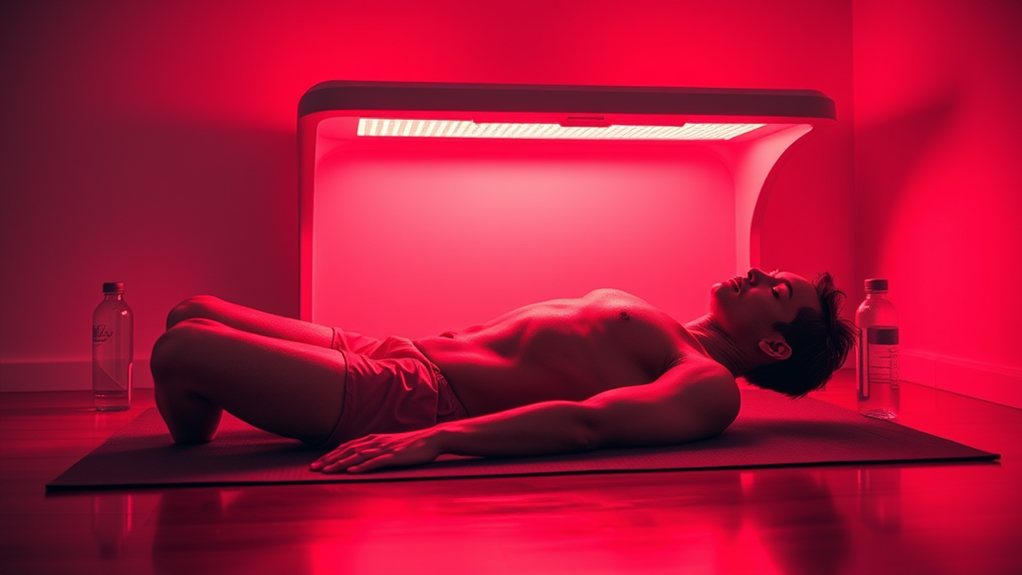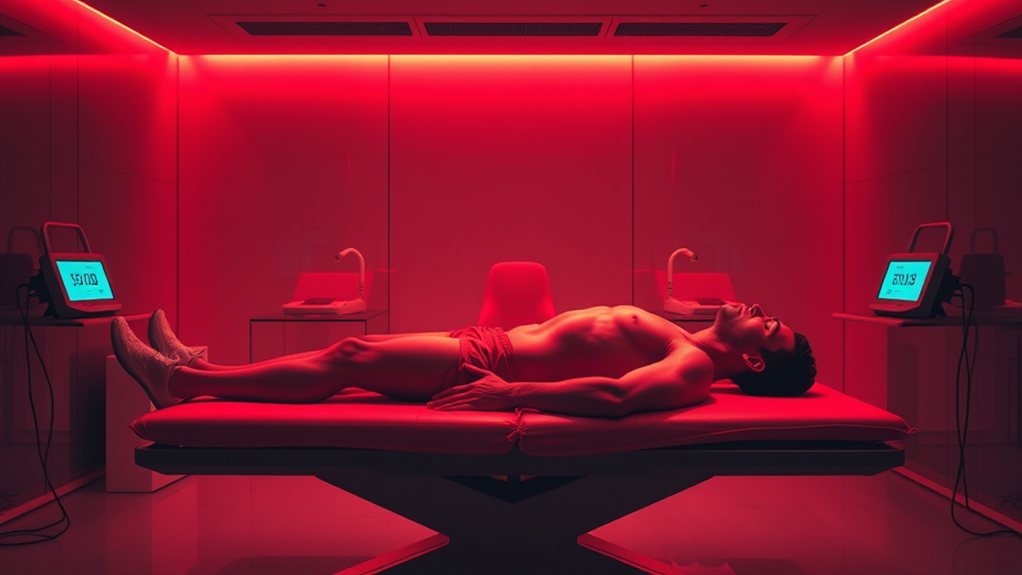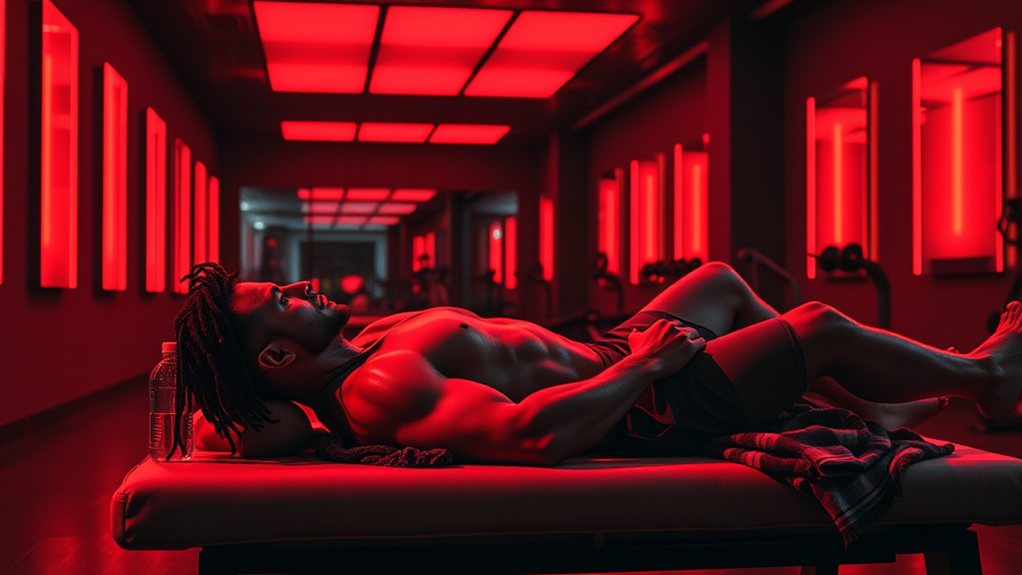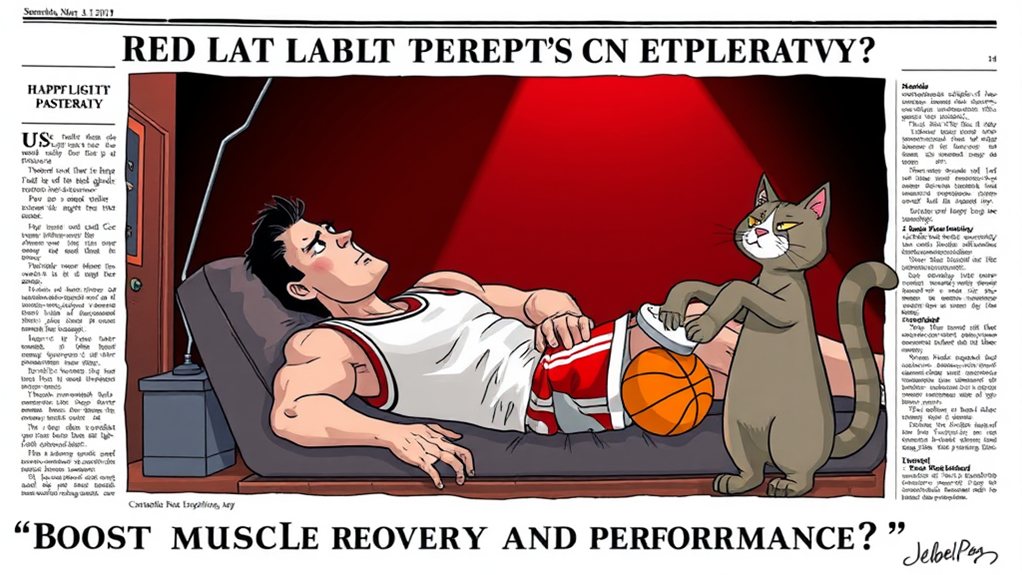Red light therapy effectively boosts muscle recovery and performance by improving cellular energy production, increasing ATP levels by up to 200%. This process accelerates healing, reduces post-exercise soreness, and improves circulation for better nutrient delivery. Additionally, it mitigates inflammation, allowing for quicker recovery from prolonged fatigue and stiffness. When incorporated into your routine, red light therapy can greatly enhance your athletic performance. Discover how to maximize these benefits and additional insights as we investigate further details.
Key Takeaways
- Red light therapy enhances mitochondrial function, increasing ATP production essential for muscle recovery and performance.
- It accelerates healing and reduces muscle soreness following intense exercise, promoting faster recovery.
- Improved circulation from red light therapy aids in nutrient delivery and waste removal, benefiting athletic performance.
- The therapy effectively reduces inflammation, addressing prolonged soreness and enhancing overall recovery techniques.
- Generally safe with minimal side effects, red light therapy can be used by most individuals to boost athletic performance.
What Is Red Light Therapy?

Red light therapy (RLT) utilizes low-level wavelengths of light, typically in the red and near-infrared spectrum, in order to stimulate cellular processes.
Historically, RLT emerged from studies in the 1960s when researchers observed its effects on wound healing. As technology advancements progressed, devices became more accessible, allowing both clinical and home use.
RLT works by enhancing mitochondrial function, which boosts ATP production, crucial for muscle recovery. This therapy has drawn attention in sports medicine and wellness communities, providing a sense of belonging among those seeking effective recovery methods.
How Does Red Light Therapy Work?
When you expose your tissues to specific wavelengths of light, cellular processes are stimulated, leading to improved recovery.
Red light therapy primarily utilizes wavelengths between 600 and 900 nanometers, which penetrate your skin and engage cellular mechanisms within your muscles. This light activates mitochondria, boosting ATP production and enhancing energy levels for your cells.
As a result, your body can more effectively repair damaged tissues and reduce inflammation. Moreover, this therapy promotes the release of nitric oxide, which improves blood flow, delivering crucial nutrients to your muscles.
Benefits of Red Light Therapy for Muscle Recovery

The application of red light therapy yields considerable benefits for muscle recovery, improving your body's natural healing processes.
It's a promising addition to your recovery techniques, especially if you're dealing with muscle soreness. Here are three key benefits:
- Accelerated Healing: Red light therapy stimulates cellular energy production, promoting faster tissue repair and reducing downtime after intense workouts.
- Decreased Muscle Soreness: Research shows that it can considerably lower post-exercise soreness, allowing you to return to your routine more quickly.
- Improved Circulation: Enhanced blood flow from red light therapy aids in nutrient delivery and waste removal, further supporting recovery.
Incorporating red light therapy into your regimen can transform your approach to muscle recovery and help you feel more connected to your body's healing capabilities.
Red Light Therapy and Inflammation Reduction
While inflammation is a natural response toward muscle injury and stress, it can hinder recovery and performance.
Red light therapy utilizes therapeutic wavelengths to penetrate your skin, stimulating cellular processes that reduce inflammation. Studies show that this therapy can modulate the inflammation response, promoting faster healing of damaged tissues.
When you expose your muscles to red light, it improves mitochondrial function, leading to increased ATP production and enhanced blood circulation. This process helps clear out inflammatory markers, which are often responsible for prolonged soreness and stiffness.
Enhancing Athletic Performance With Red Light Therapy

As you seek to improve your athletic performance, incorporating red light therapy can be a game changer. This innovative approach not only boosts muscle endurance but also improves overall performance.
Here are three key benefits you might experience:
- Increased ATP Production: Red light therapy stimulates mitochondria, leading to improved energy production, essential for sustained performance.
- Improved Blood Flow: Enhanced circulation facilitates nutrient delivery and waste removal, supporting muscle recovery and endurance during intense workouts.
- Reduced Muscle Fatigue: By mitigating oxidative stress, red light therapy helps you maintain peak performance levels for longer periods.
Integrating red light therapy into your routine could provide the competitive edge you need, fostering a sense of belonging among like-minded athletes aiming for excellence.
Recent Research on Red Light Therapy in Sports
Recent studies have illuminated the potential of red light therapy (RLT) as a valuable tool in sports medicine, demonstrating its efficacy in enhancing recovery and performance among athletes.
Recent advancements in clinical trials indicate that RLT can considerably reduce muscle soreness and inflammation post-exercise, allowing for quicker recovery times. In one randomized controlled trial, athletes receiving RLT reported decreased pain and improved muscle function compared to those who didn't.
Additionally, studies show that RLT may stimulate mitochondrial activity, enhancing ATP production, which is vital for energy during high-intensity training.
These findings suggest that incorporating RLT into athletic training regimens couldn't only boost performance but also foster a sense of community among athletes seeking innovative recovery methods.
How to Incorporate Red Light Therapy Into Your Routine
Incorporating red light therapy into your routine can improve recovery and optimize athletic performance. To effectively implement this therapy, contemplate these key steps:
- Home Setup: Choose a quality red light therapy device suitable for your space. Verify it covers the muscle groups you want to target.
- Session Timing: Schedule sessions post-workout or on rest days. Aim for 10-20 minutes per area, allowing your body to absorb the light effectively.
- Frequency: Consistency is crucial. Start with 3-5 sessions each week, gradually adjusting based on your recovery needs and performance goals.
Safety and Side Effects of Red Light Therapy
While red light therapy is generally regarded safe for most individuals, it's important to be aware of potential side effects and contraindications. Common side effects can include temporary redness or irritation at the treatment site, which usually resolves quickly.
To guarantee your safety, contemplate these precautions: avoid direct exposure to the eyes and consult a healthcare professional if you're pregnant, have a history of skin sensitivity, or are taking medications that can cause photosensitivity.
Understanding these factors can help you maximize the benefits of red light therapy while minimizing risks. By staying informed and following recommended guidelines, you can confidently integrate this therapy into your routine and enjoy its potential advantages for muscle recovery and performance.
Future Directions in Red Light Therapy Research
As researchers continue to investigate the potential of red light therapy, future studies are likely to focus on optimizing treatment parameters, such as wavelength, intensity, and duration, in order to improve muscle recovery outcomes.
You'll find that these investigations will examine:
- Individualized protocols that cater to specific athletic needs and recovery timelines.
- Innovative devices incorporating future technologies to augment light delivery and effectiveness.
- Clinical applications in diverse populations, including athletes, older adults, and those with chronic injuries.
These advancements aim to provide evidence-based solutions and deepen your understanding of red light therapy's role in performance enhancement.
Frequently Asked Questions
Can Red Light Therapy Be Used for Non-Athletic Muscle Recovery?
Yes, you can use red light applications for non-athletic muscle recovery. Studies show it boosts healing, reduces soreness, and improves circulation, making it an effective option for anyone seeking relief and support in muscle recovery.
How Often Should You Use Red Light Therapy for Optimal Results?
In order to reap the benefits, think of red light therapy like watering a plant. Frequency recommendations suggest sessions three to five times weekly, alongside treatment durations of 10 to 20 minutes for ideal results. Consistency's key!
Are There Specific Devices Recommended for Red Light Therapy?
When choosing red light therapy devices, contemplate types like handheld units or larger panels. Follow usage guidelines for ideal results, ensuring the device's wavelength and intensity align alongside your recovery and performance goals for best outcomes.
Is Red Light Therapy Safe for All Age Groups?
Red light therapy's generally safe across all age groups, but you should always follow safety guidelines. Take into account age variations in skin sensitivity and consult a healthcare professional to ascertain it's appropriate for your specific needs.
Can Red Light Therapy Aid in Injury Rehabilitation?
Like a guiding light of hope, red light therapy can greatly improve injury healing and provide pain relief. By stimulating cellular repair, you might experience faster recovery, allowing you to return for your activities accompanied by renewed strength.
Conclusion
Incorporating red light therapy into your recovery routine could be like giving your muscles a gentle sunrise, awakening them to rejuvenation and improved performance. As you bask in the soothing glow, you might feel inflammation retreating, leaving behind a sense of relief and energy. Through ongoing research illuminating its potential, you're not just investing in recovery; you're embracing a scientifically-backed method to lift your athletic prowess. The future of your performance might just shine brighter using this innovative therapy.
